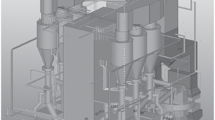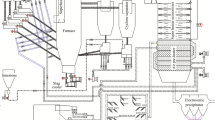Abstract
The large-scale integration of new energy generation has put forward higher requirements for the peak-shaving capability of thermal power. The circulating fluidized bed (CFB) depends on the advantages of a wide load adjustment range and low cost of pollutant control to become a good peak shaving power supply. However, the large delay and inertia caused by its unique combustion mode make it very difficult to change the load quickly. To further understand the factors that affect the load change of CFB, and explore the method of increasing CFB load change rate, the load change experiment on the combustion side was carried out in the 0.1 MW CFB experiment platform. The influence law of bed material amount and fuel particle size on load change of CFB combustion side was revealed for the first time. The results indicated that the increase of bed material amount was beneficial to improve the load change rate on the combustion side of CFB and reduce the carbon content of fly ash, but had no obvious effect on NOx emission. When the bed height at rest increased from 200 mm to 400 mm, the load change rate of the CFB combustion side load from 50% to 75% increased from 0.78%/min to 1.14%/min, and the carbon content of fly ash at 75% load decreased from 26.6% to 24.9%. In addition, the reduction of fuel particle size positively improved the load change rate on the combustion side of the CFB and reduced NOx emission but had a negative effect on reducing the carbon content of fly ash. When the fuel particle size decreased from 0–1 mm to 0–0.12 mm, the load change rate of CFB combustion side load from 50% to 75% increased from 0.78%/min to 1.09%/min, and the NOx emission and carbon content of fly ash at 75% load decreased from 349.5 mg/m3 to 194.1 mg/m3 and increased from 26.6% to 31.8%, respectively.
Similar content being viewed by others
References
Li J., Liu Q., Forecasting of short-term photovoltaic power generation using combined interval type-2 Takagi-Sugeno-Kang fuzzy systems. International Journal of Electrical Power & Energy Systems, 2022, 140: 108002.
Tabar M.R.R., Anvari M., Lohmann G., et al., Kolmogorov spectrum of renewable wind and solar power fluctuations. European Physical Journal-Special Topics, 2014, 223(12): 2637–2644.
Shi R., Fan X., He Y., Comprehensive evaluation index system for wind power utilization levels in wind farms in China. Renewable & Sustainable Energy Reviews, 2017, 69: 461–471.
Ren G., Wan J., Liu J., et al., Analysis of wind power intermittency based on historical wind power data. Energy, 2018, 150: 482–492.
Zhu S., Hui J., Lyu Q., et al., Experimental study on pulverized coal combustion preheated by a circulating fluidized bed: Preheating characteristics for peak shaving. Fuel, 2022, 324: 124684.
Gonzalez-Salazar M.A., Kirsten T., Prchlik L., Review of the operational flexibility and emissions of gas- and coal-fired power plants in a future with growing renewables. Renewable and Sustainable Energy Reviews, 2018, 82: 1497–1513.
Gu Y., Xu J., Chen D., et al., Overall review of peak shaving for coal-fired power units in China. Renewable and Sustainable Energy Reviews, 2016, 54: 723–731.
Lockwood T., Techno-economic analysis of PC versus CFB combustion technology. IEA Clean Coal Centre, 2013.
Xie H., Ren S., Xie Y., Jiao X., Development opportunities of the coal industry towards the goal of carbon neutrality. Journal of China Coal Society, 2021, 46(7): 2197–2211. (in Chinese)
Peters J., Alobaid F., Epple B., Operational flexibility of a CFB furnace during fast load change—Experimental measurements and dynamic model. Applied Sciences, 2020, 10(17): 5972.
Basu P., Combustion of coal in circulating fluidized-bed boilers: A review. Chemical Engineering Science, 1999, 54(22): 5547–5557.
Henderson C., Increasing the flexibility of coal-fired power plants. IEA Clean Coal Centre, 2014.
Cai J., Shan L., Wang Z., et al., Variable load characteristics of a supercritical 350 MW circulating fluidized bed boiler. Thermal Power Generation, 2020, 49(9): 98–103,108. (in Chinese)
Alobaid F., Peters J., Epple B., Experimental measurements for Polish lignite combustion in a 1 MWth circulating fluidized bed during load changes. Energy, 2021, 228: 120585.
Zhang P., Fan H., Yu Y., et al., Performance of 350 MW supercritical circulating fluidized bed boiler under different loads. Clean Coal Technology, 2021, 27(6): 93–99. (in Chinese)
Zhang S., Zhang S., Zhang J., et al., Performance research on deep peak regulation with flue gas recirculation in a 330 MW CFB boiler. Clean Coal Technology, 2021, 27(01): 291–298. (in Chinese)
Huttunen M., Peltola J., Kallio S., et al., Analysis of the processes in fluidized bed boiler furnaces during load changes. Energy Procedia, 2017, 120: 580–587.
Gao M., Hong F., Liu J., Investigation on energy storage and quick load change control of subcritical circulating fluidized bed boiler units. Applied Energy, 2017, 185: 463–471.
Gao M., Hong F., Liu J., Chen F., Investigation on the energy conversion and load control of supercritical circulating fluidized bed boiler units. Journal of Process Control, 2018, 68: 14–22.
Hong F., Chen J., Wang R., et al., Realization and performance evaluation for long-term low-load operation of a CFB boiler unit. Energy, 2021, 214: 118877.
Zhang F., Xue Y., Li D., et al., On the flexible operation of supercritical circulating fluidized bed: Burning carbon based decentralized active disturbance rejection control. Energies, 2019, 12(6): 1132.
Liu Z., Ma S., Pan X., Chen J., Experimental study on the load response rate under the dynamic combined combustion of PC coal and CFB coal in a CFB boiler. Fuel, 2019, 236: 445–451.
Xian X., Du Y., Zhang G., Combustion characteristics of coal blending by TG-DTG/DTA. Coal Conversion, 2011, 34(3): 67–70. (in Chinese)
Brunauer S., Emmett P.H., Teller E., Adsorption of gases in multimolecular layers. Journal of American Chemical Society, 1938, 60(2): 309–319.
Ustinov E.A., Do D.D., Fenelonov V.B., Pore size distribution analysis of activated carbons: Application of density functional theory using nongraphitized carbon black as a reference system. Carbon, 2006, 44(4): 653–663.
Basu P., Nag P.K., An investigation into heat transfer in circulating fluidized beds. International Journal of Heat and Mass Transfer, 1987, 30(11): 2399–2409.
Ebert T.A., Glicksman L.R., Lints M., Determination of particle and gas convective heat transfer component in circulating fluidized bed. Chemical Engineering Science, 1993, 48(12): 2179–2188.
Liu C., Li C., Li Y., et al., Heat transfer enhancement in gas-solid flow. CIESC Journal, 2014, 7: 2485–2494. (in Chinese)
Friebel J., Kopsel R.F.W., The fate of nitrogen during pyrolysis of German low rank coals—A parameter study. Fuel, 1999, 78(8): 923–932.
DeDiego L.F., Londono C.A., Wang X.S., Gibbs B.M., Influence of operating parameters on NOx and N2O axial profiles in a circulating fluidized bed combustor. Fuel, 1996, 75(8): 971–978.
Ke X., Cai R., Yang H., et al., Formation and ultra-low emission of NOx for circulating fluidized bed combustion. Proceedings of the CSEE, 2018, 38(2): 7. (in Chinese)
Yang H., Zhang H., Yang S., et al., Effect of bed pressure drop on performance of a CFB boiler. Energy & Fuels, 2009, 23(5–6): 2886–2890.
Neshumayev D., Rummel L., Konist A., et al., Power plant fuel consumption rate during load cycling. Applied Energy, 2018, 224: 124–135.
Kubik M.L., Coker P.J., Barlow J.F., Increasing thermal plant flexibility in a high renewables power system. Applied Energy, 2015, 154: 102–111.
Xiao Y., Song G., Yang X., et al., Influence of stoichiometry air ratio on char characteristics and nitrogen conversion in circulating fluidized bed with post-combustion. Fuel, 2021, 298: 120842.
Zheng J., He H., Factors related to the residence time of fine particle concerning the burnout of Fujian anthracite during combustion in CFB boiler. International Conference on Power Engineering (ICOPE-2007), Hangzhou, China, 2007, pp. 864–867.
Thomas K.M., The release of nitrogen oxides during char combustion. Fuel, 1997, 76(6): 457–473.
Molina A., Eddings E.G., Pershing D.W., Sarofim A.F., Reduction of nitric oxide on the char surface at pulverized combustion conditions. Proceedings of the Combustion Institute, 2002, 29: 2275–2281.
Wei L., Jiang X., Zhang C., Li R., A experimental investigation on nitrogen emission properties of micro-pulverized during pyrolysis. Proceedings of the Chinese Society of Electrical Engineering, 2006, 26(7): 62–66. (in Chinese)
Zhang Y., Yu J., Lin C., et al., Influence of particle sizes of bed material and fuel on denitration reaction in circulating fluidized bed. Clean Coal Technology, 2020, 26(06): 196–202. (in Chinese)
Li J., Zhang M., Yang H., et al., The theory and practice of NOx emission control for circulating fluidized bed boilers based on the re-specification of the fluidization state. Fuel Processing Technology, 2016, 150: 88–93.
Yang Q., Li Z., Xu Y., Study on the special resistance characteristics of fly ash. Energy Reports, 2022, 8: 706–712.
Acknowledgments
This work was supported by the Strategic Priority Research Program of the Chinese Academy of Sciences (Grant No. XDA21040100).
Author information
Authors and Affiliations
Corresponding author
Ethics declarations
On behalf of all authors, the corresponding author states that there is no conflict of interest.
Rights and permissions
About this article
Cite this article
Tang, Z., Song, G., Jiang, Y. et al. Experimental Study on the Effect of Bed Material Amount and Fuel Particle Size on Load Change of Circulating Fluidized Bed. J. Therm. Sci. 32, 1758–1770 (2023). https://doi.org/10.1007/s11630-023-1866-z
Received:
Published:
Issue Date:
DOI: https://doi.org/10.1007/s11630-023-1866-z




